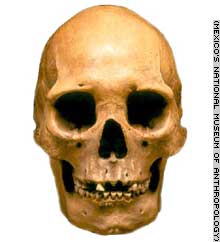
Anonymous - 12-4-2002 at 12:01 AM
http://www.cnn.com/2002/TECH/science/12/03/oldest.skull/inde...
By Jeordan Legon
CNN
December 3, 2002
Researchers said it may be the oldest skull ever found in the Americas: an elongated-faced woman who died about 13,000 years ago.
But perhaps more significant than the age, researchers said, is that the skull and other bones were found while digging a well near Mexico City
International Airport. Because the remains were discovered outside the United States, scientists will be able to study the DNA and structure of the
skeleton without the objection of Native American groups, who can claim and rebury ancestral remains under a 1990 U.S. law.
"Here Mexico is providing the opportunity to see what clues these bones can yield about man's arrival in the American continent," Mexican
anthropologist Jose Concepcion Jimenez Lopez said.
The oldest skull up to now, believed to be that of "Buhl Woman," was found in 1989 at a gravel quarry in Idaho. Scientists said it dates back 10,500
to 11,000 years. But researchers scarcely studied those bones before the Shoshone-Bannock tribe claimed and reburied them.
The "Pe?on Woman III" -- which scientists believe is now the oldest skull from the New World -- has been sitting in Mexico City's National Museum of
Anthropology since 1959.
At the insistence of geologist Silvia Gonzalez, who had a hunch that the bones were older than previously thought, the remains were taken to Oxford
University to be carbon-dated. And indeed, tests proved Gonzalez's assertion.
Scientists said they believe that the Pe?on Woman died anywhere from 12,700 to 13,000 years ago at the age of 27.
Emboldened by her finding, Gonzalez will try to prove her theory that the bones of the Pe?on Woman belong not to Native Americans, but to descendants
of the Ainu people of Japan.
She said she bases her hypothesis on the elongated, narrow shape of the Pe?on Woman's skull. Native Americans, she said, are round-faced with broad
cheeks. "Quite different from Pe?on Woman," she said.
She said she believes descendants of the Ainu people made their way to the New World by island hoping on boats.
"If this proves right, it's going to be quite contentious," said Gonzalez, who teaches at John Moores University in England and received a grant last
week from the British government to conduct her research. "We're going to say to Native Americans, 'Maybe there were some people in the Americas
before you, who are not related to you.' "
Gonzalez's theory is controversial but gaining credence in scientific circles, where up to now many believed hardy mammoth hunters were first to
arrive in the Americas 14,000 to 16,000 years ago by crossing into Alaska from Siberia.
Gonzalez and other scientists said they believe people may have arrived in America as much as 25,000 years ago. She points to evidence of camps --
man-made tools, a human footprint and huts dating back 25,000 years -- that have been found in Chile as evidence of man's imprint on the Americas long
before mammoth hunters.
Searching for answers to coastal migration
Gonzalez will embark on a three-year journey to prove her theory. As part of that journey, she will travel to Baja California to study the Pericue
people, who shared the same elongated faces of the Pe?on Woman. She said she believes that the Pericue, who for unknown reasons went extinct in the
18th century, may hold the answers to coastal migration of man from Asia to America.
The bones of the Pe?on Woman will have DNA extracted to compare it with genetic matter of the Pericue, she said. Scientists also said they hope to
study clothes fibers found near the skeleton and try to piece together how the woman died. Gonzalez said the skeleton does not show any wounds or
obvious injuries.
"We still have a long way to go," she said. "But we have a good start."

Excelent
JESSE - 12-4-2002 at 01:05 AM
Great report!!!! keep us informed on other developments about this subject.
Stephanie Jackter - 12-4-2002 at 06:26 AM
Yes. Fascinating. I saw a report on 60 minutes a year or two ago about the reburial of the Kenewick Man site, an anthropological treasure trove
found in Washington State, I believe, which could have told us a great deal about the earliest Americans to the northernmost part of North America.
Siding with the Indian tribes there to force reburial, the Army Corp of Engineers threw tons of rock on top of the riverbed area where Keniwick Man
had been discovered (unburied naturally by time and elements), and virtually destroyed the site.
We are losing so much historical information from development and the hurried excavation of sites that are scheduled for construction by "cultural
resource management" teams, that when we do come across a site that can be studied for posterity, we should treat it with the utmost respect. It's
fortunate that the ancient woman from this article was finally discovered to be who she was, but nevertheless a shame that the site she was taken
from, which could have revealed much more data and context of how she lived, has now probably been forever altered by development, taking with it the
majority of the information we might have found out about her. - Stephanie
Stephanie Jackter - 12-10-2002 at 08:05 PM
There's a fascinating program on Kenewik man on PBS right now on Nova. Definitely worth checking out.- Stephanie
